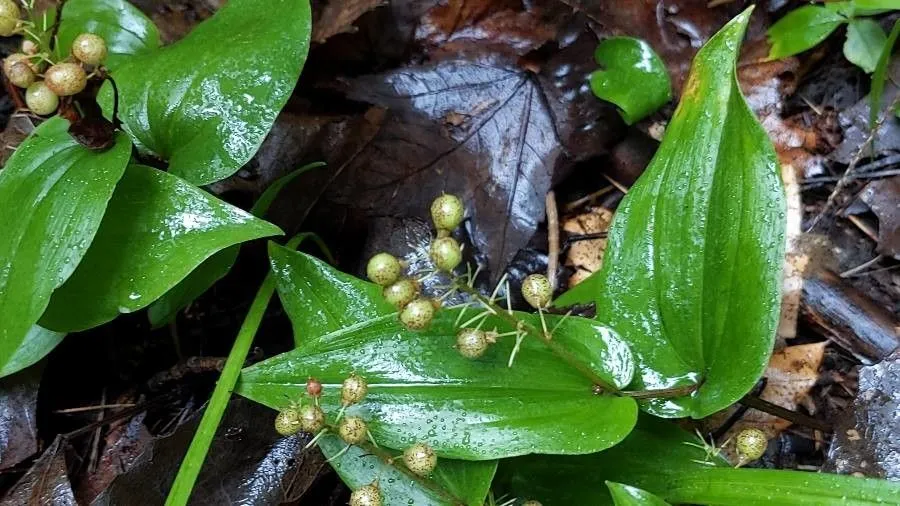
Author: Desf.
Bibliography: Ann. Mus. Natl. Hist. Nat. 9: 54 (1807)
Year: 1807
Status: accepted
Rank: species
Genus: Maianthemum
Vegetable: False
Observations: Subarctic America to NC. & EC. U.S.A.
The Canadian may-lily, scientifically known as Maianthemum canadense, is a delicate and enchanting plant that bears subtle and graceful beauty. Described in the annals of botanical literature back in 1807 by the renowned botanist Desfontaines, this perennial herb has captivated the hearts of nature enthusiasts and botanists alike.
Belonging to the diverse Asparagaceae family, the Canadian may-lily is notable for its understated elegance and resilience. It typically flourishes in the undergrowth of forests spanning from Subarctic America through to North Central and Eastern Central regions of the United States. This vast range speaks to its adaptability and hardiness in varied climatic conditions.
One of the defining characteristics of Maianthemum canadense is its charming appearance. In spring, the plant graces woodland floors with its attractive, tiny, star-shaped white flowers that emerge in clusters. These blossoms rest upon slender, curved stems that can reach up to 15 centimeters (6 inches) in height, making a gentle yet striking addition to the muted tones of forest floors. The leaves are heart-shaped at the base, with pointed tips, and form a lush, green carpet that heralds the arrival of warmer days.
After the flowering season, the Canadian may-lily produces small, bright red berries that add a splash of color to its green foliage. These berries are not only visually appealing but also play a role in the plant’s reproductive cycle, as they attract birds and small mammals that facilitate seed dispersal.
Ecologically, Canadian may-lilies thrive in shaded, moist environments, often growing in dense colonies that enhance soil stability and contribute to the health of forest ecosystems. Moreover, their presence is an indicator of a well-established, undisturbed forest habitat, making them a valued species for conservation efforts.
In summary, the Canadian may-lily, Maianthemum canadense, is a remarkable plant that stands as a testament to the subtle beauty and intricate interconnections of forest ecosystems. Its history, morphological traits, and ecological contributions make it a noteworthy species within the Asparagaceae family and a true gem of North American woodlands.
Eng: canada mayflower, canadian may-lily, false lily-of-the-valley, two-leaf-solomon’s-seal, wild lily-of-the-valley, canada beadruby, canadian may lily, two-leaved solomon’s seal
Deu: kanadisches schattenblümchen
Fra: maïanthème du canada
Swe: kanadensiskt ekorrbär
En: Canadian May-lily, False lily-of-the-valley, Wild lily-of-the-valley, Two-leaf-Solomon’s-seal, Canada mayflower, TWOLEAVED SOLOMONSEAL, Canada beadruby, Canadian May lily, Two-leaved Solomon’s seal
Fi: Kanadanoravanmarja
Fr: Maïanthème du Canada
De: Kanadisches Schattenblümchen
Sv: Kanadensiskt ekorrbär
Taken Aug 14, 2019 by Chris Chris Wilby (cc-by-sa)
Taken Oct 31, 2022 by Nevada Collins (cc-by-sa)
Taken Sep 22, 2022 by Sue Niemi (cc-by-sa)
Taken Aug 14, 2021 by tmzante (cc-by-sa)
Taken Oct 27, 2019 by Aphra B. (cc-by-sa)
Taken May 18, 2020 by house b (cc-by-sa)
Taken Apr 29, 2021 by J Mill (cc-by-sa)
Taken Aug 14, 2021 by tmzante (cc-by-sa)
Taken Aug 14, 2021 by J Vandenberg (cc-by-sa)
Taken Sep 4, 2021 by Rosalee Lamm (cc-by-sa)
Taken Jun 10, 2019 by Samantha Benjamin (cc-by-sa)
Taken May 28, 2021 by steve steve chant (cc-by-sa)
Taken May 31, 2021 by Michael Clermont (cc-by-sa)
Taken May 22, 2021 by Lucie Claude (cc-by-sa)
Taken Jun 3, 2021 by Fortier Marie-Josée (cc-by-sa)
Taken Aug 31, 2014 by EOL − Alice (cc-by-nc)
Taken Aug 27, 2014 by EOL − Charlie Hohn (cc-by-nc)
Taken May 25, 2019 by mid gu (cc-by-sa)
Taken Jul 4, 2021 by Tasha Tchek (cc-by-sa)
Taken Sep 14, 2020 by Chantal Marie Berthelot (cc-by-sa)
Taken Jul 5, 2020 by Joseph Moulaison (cc-by-sa)
Taken Apr 21, 2019 by Christopher Gadson (cc-by-sa)
Family: Myrtaceae Author: (F.Muell.) K.D.Hill & L.A.S.Johnson Bibliography: Telopea 6: 402 (1995) Year: 1995 Status:…
Family: Rubiaceae Author: Pierre ex A.Froehner Bibliography: Notizbl. Bot. Gart. Berlin-Dahlem 1: 237 (1897) Year:…
Family: Sapindaceae Author: Koidz. Bibliography: J. Coll. Sci. Imp. Univ. Tokyo 32(1): 38 (1911) Year:…
Family: Asteraceae Author: A.Gray Bibliography: Pacif. Railr. Rep.: 107 (1857) Year: 1857 Status: accepted Rank:…
Family: Fabaceae Author: Medik. Bibliography: Vorles. Churpfälz. Phys.-Ökon. Ges. 2: 398 (1787) Year: 1787 Status:…
Family: Aspleniaceae Author: (Cav.) Alston Bibliography: Bull. Misc. Inform. Kew 1932: 309 (1932) Year: 1932…